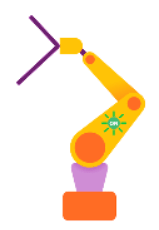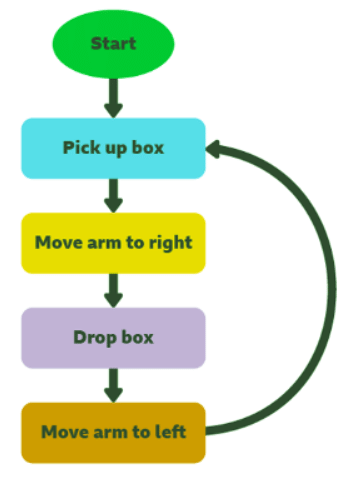Year 3 Exam > Year 3 Notes > Year 3 Computing > Real life robots
Real life robots | Year 3 Computing PDF Download
| Table of contents |

|
| Understanding Robots |

|
| How do robots work? |

|
| How do we control a robot? |

|
| Are robots better than humans? |

|
Understanding Robots
- A robot is a mechanical or virtual artificial agent, usually an electro-mechanical machine that is guided by a computer program or electronic circuitry.
- Contrary to popular imagination influenced by science fiction, real robots are not necessarily humanoid in appearance or behavior.
- Real robots are designed to perform tasks autonomously, without constant human intervention.
- These machines operate based on pre-programmed instructions and algorithms, following a set of rules dictated by their programming.
How do robots work?
- Robots are equipped with a computer processor, which serves as the brain of the machine. This processor is responsible for managing and coordinating all other components within the robot.
- Input and output mechanisms are integrated into robots to facilitate their functioning. Input refers to the data that is received by the robot for processing, while output signifies the information that is generated and transmitted by the robot.
Inputs
Inputs refer to the components of a robot that gather information and transmit it to the computer processor. Some examples of inputs include:
Some examples of inputs include:
- A sensor: This is a device that collects data about the robot's surroundings and sends it to the computer processor.
- Buttons: These are used to start or stop the robot.
- Remote control: Enables the robot to be controlled from a distance.
Outputs
Outputs are the components that receive information from the computer processor and assist the robot in performing its intended tasks. Some outputs include:
Some outputs include:
- Motors: A motor is a mechanical device that generates turning motion when activated. It is crucial for making the robot move effectively.
- Lights: Lights play a vital role in indicating whether the robot is powered on or off. They provide visual cues to the operators.
- Sounds: Sounds are used by robots to convey information. For example, a robot may produce a specific sound to signal the completion of a task.
Question for Real life robotsTry yourself: Which component of a robot is responsible for collecting data about the robot's surroundings and sending it to the computer processor?View Solution
How do we control a robot?
- We control robots by giving them instructions through a computer program.
- The computer program is sent to the robot's built-in computer processor.
- The computer processor uses the program to instruct different parts of the robot to complete tasks.

Programming Robots:
- When people program robots, they use sequencing and repetition to make the programs efficient.
Sequencing and Repetition in Programming:
- Sequencing involves putting instructions in the correct order.
- Repetition is about repeating a small task multiple times.

Example of Programming a Packing Robot:
- The program for a packing robot involves sequencing and repetition.
- An example algorithm for a packing robot might include steps like picking up a box, moving the arm, dropping the box, and repeating the process.
Are robots better than humans?
Robots possess several advantages over humans due to their accuracy, speed, and ability to perform repetitive tasks without fatigue:
- Efficiency and Repetition: Robots excel at repeating tasks without pause, making them ideal for jobs that are monotonous for humans.
- Strength and Endurance: They can handle heavy lifting and strenuous tasks that may be challenging for humans.
- No Biological Needs: Robots do not require sustenance like food, water, or air, enabling them to operate in environments that are inhospitable to humans.
- Precision in Task Execution: Engineers design robots to specialize in particular tasks, ensuring exceptional performance in those areas.
Examples of Real Robots
- Manufacturing Robots: These robots are involved in assembling cars by cutting and joining metal parts together, a task that is physically demanding and hazardous for human workers.
- Packing and Sorting Robots: These robots are responsible for sorting, packing, and labeling parcels for shipping, tasks that require continuous operation and the ability to lift heavy packages.
- Space Exploration Robots: Robots are pivotal in exploring distant planets, allowing scientists to conduct missions remotely from Earth, reducing costs and risks associated with manned missions.
- Tactical Robots: Designed for handling hazardous materials like explosives, these robots are remotely operated to ensure the safety of personnel.
- Household Robots: These robots are designed for home use, such as automated floor cleaning, providing convenience and saving time for homeowners.
Robots at home
- Robots are capable of automating household chores such as floor cleaning, making life more convenient for individuals.
- These autonomous cleaning robots can navigate around obstacles, ensuring efficient cleaning without human intervention.
- By operating even in the absence of individuals, these robots save time and effort, offering a valuable solution for busy households.
The document Real life robots | Year 3 Computing is a part of the Year 3 Course Year 3 Computing.
All you need of Year 3 at this link: Year 3
|
13 videos|26 docs|8 tests
|
FAQs on Real life robots - Year 3 Computing
| 1. What are some examples of industries where robots are commonly used? |  |
Ans. Robots are commonly used in industries such as manufacturing, healthcare, agriculture, automotive, and logistics.
| 2. How are robots being utilized in the education sector in the UK? |  |
Ans. In UK schools, robots are being used to enhance STEM education, teach programming skills, and provide interactive learning experiences for students.
| 3. Can you provide some examples of real-life robots used in different fields? |  |
Ans. Some examples of real-life robots include robotic arms used in manufacturing, surgical robots in healthcare, drones in agriculture, and autonomous vehicles in logistics.
| 4. What are the benefits of incorporating robotics in various industries? |  |
Ans. Incorporating robotics in industries can lead to increased efficiency, improved accuracy, cost savings, enhanced safety for workers, and the ability to perform tasks in challenging environments.
| 5. How can students in the UK benefit from learning about robotics in schools? |  |
Ans. Learning about robotics in schools can help students develop critical thinking skills, problem-solving abilities, creativity, and prepare them for future careers in STEM fields.
Related Searches














